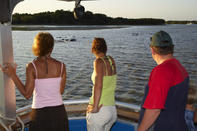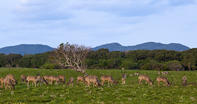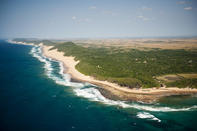A Bush-and-Beach Holiday
A visit to the isiMangaliso Wetland Park allows for a bush-and-beach holiday unlike any other in South Africa. For many visitors, it is Maputaland’s coastline that is the major drawcard.

Most start their journey in the town of St Lucia, a centre for activities and a convenient jumping-off point for the region’s attractions. It used to be a surf-anglers’ haven, but since the ban on beach driving, a new breed of eco-tourists have taken over, many of them foreign and lured by the area’s status as a World Heritage Site.
There’s a wide, hummocked beach, an estuary thronged with wildlife, a cultural village, self-guided trails, whale-watching trips and boating activities as well as a fine Crocodile Centre run by KwaZulu-Natal Wildlife. Being a town within a park, you get the occasional leopard picking off the residents’ cats and dogs, and you may well bump into a hippo on the way home from the pub.
The estuary itself suffers from severe droughts and can be a puddle of its former self. But rangers are quick to point out that this is part of a natural cycle and it would be foolhardy to tamper with the ecology by opening the mouth to allow seawater in.
The Eastern Shores

North of St Lucia town there are a number of excellent touring options. Cape Vidal Camp is an old favourite among those in the know and the Eastern Shores Reserve, which surrounds it has forested dune and lakeshore habitats that are good for game viewing. Apart from a profusion of reedbuck, kudu, waterbuck and smaller antelope – especially red duikers – there were plenty of sightings of white rhinos (wallowing in muddy pools due to the heat) and buffaloes (packed into the shade of insubstantial trees).
Since the inscription of World Heritage status, the Eastern Shores State Forest has been cleared of alien vegetation (leaving a landscape dotted with tree stumps), making the prospect of rehabilitation very bright. An astonishing six-million conifers have been felled and into the newly created grasslands locally extinct species such as elephant, wild dog and cheetah have been reintroduced.
Up North

Further north, Sodwana Bay is the most popular dive spot on this stretch of coast, probably in all of South Africa. The place can get a bit overrun during school holidays, but the reefs are sensational. Beyond Sodwana, the coast is wild and beguiling. I stayed at Rocktail Bay, a venerable Wilderness Safaris lodge in the forest north of Lake Sibaya.
Log-and-canvas A-frame chalets sit on stilts in the trees, the beach is just over the dune and there are secluded bowers with hammocks where the monkey-loud foliage presses in from all sides. To the north, near the Mozambican border, is Kosi Bay, a series of eight lakes running north–south and graduating from salt to fresh water. It’s a pristine corner of South Africa, rich in a diversity of habitats ranging from swamp forest to palm groves.
One of the main attractions is the centuries-old fish traps of the Thonga people. These ‘kraals’ form a maze of wooden stockades that funnel fish into a basket-like net where they can be speared.
By Justin Fox